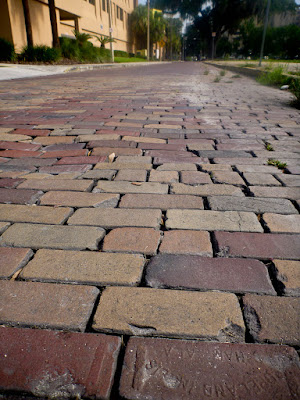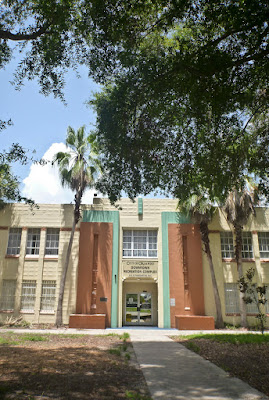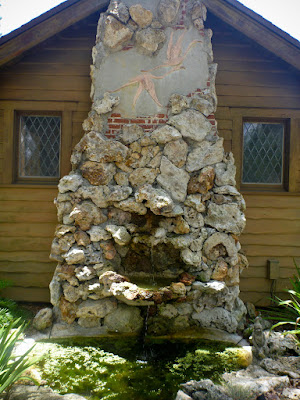I was excited to embark on my
5th Annual Freedom Ride, a
tradition in which I enjoy the freedom of
riding my bike with no agenda other than
taking photos of whatever strikes my fancy. My odyssey began at an industrial area between the newly renovated Orlando Train Station and I-4, an area normally too busy to ride a bike. On this day, however it was like a ghost town so I felt free to ride around and investigate the textures and colors created by the processes of manufacturing and recycling.
 |
| Looking for the red, white, and blue at a recycling plant. |
I remembered that nearby Kuhl Street intersected Gore and headed in that direction because the original route of the Dixie Highway through Orlando followed Kuhl Avenue briefly before rejoining Orange Avenue further south.
The Dixie Highway was a system of roads that connected the South to the Midwest in the early days of the automobile, before state and federal roads used a numbering system to identify their routes. The Western alignment of the Dixie Highway went from Chicago to Miami, going north and south through Orlando, mostly by way of Edgewater Drive and Orange Avenue. I have been been working with the
Polk County History Center on an exhibit commemorating the 100th anniversary of the creation of the Dixie Highway Association, so I've been driving as much of the original road as possible. I was thrilled to find the short stretch between Gore and Lake Lucerne still paved in bricks, perhaps the original bricks driven over by Model Ts and Stanley Steamers almost a century ago. This unexpected discovery was the first of many on this Independence Day and I realized there was a connection between the Dixie Highway and freedom. The age of the automobile brought more independence to Americans than ever before, as a vacation in Florida was now possible to a whole new class of people. Whereas before steamboats and train cars brought the American elite to places of leisure like Palm Beach, the advent of the automobile and the Dixie Highway opened the way for the middle class to visit the Sunshine State. And they've been arriving in cars by the millions ever since.

 |
| Could these bricks date back to the days of the Dixie Highway? |
 |
| Wonderful Midcentury architecture on Lake Lucerne. |
I headed to downtown where I had worked for almost a decade – a place where I'd witnessed enormous change. When I started working there soon after I moved to Central Florida, the soul of old Orlando still lingered. Places like Mac Meiner's BBQ, Chastains, and the beloved
Ronnie's Restaurant were still serving Orlando natives. Even
Sam Behr's Shoe Store still existed on Church Street. But downtown was pretty humble outside of the
Church Street Station attraction where I worked. So to find relics of the prior age feels like being an urban archaeologist, discovering pieces of a bygone age. Just by the looks of new construction near downtown, the great recession appears to be ending.
 |
A boutique hotel moved into the old Orlando Utilities Building
but left these wonderful remnants from the past behind. |
 |
| Citrus icon Dr. Phillip Phillips' legacy lives on in Orlando through the philanthropic organization of the same name. My hope is that this building bearing his name someday finds new life. |
 |
WDBO dates back to 1924 and is said to stand for "Way Down by Orlando."
It would be sad to see this wonderful Art Deco building fall by the wayside. |
I rode to a Mediterranean Revival property I knew was at risk of being torn down to make way for a high rise on Lake Eola. The charming home turned office building is a relic of an earlier age when private houses existed on the shores of Orlando's favorite park.
Historic preservation is on my mind these days as communities in Florida are faced with difficult questions of growth and property rights versus quality of life and community character. Sadly we seem to lose more and more historic buildings with character every day.
 |
| It's unlikely this 1920s home will be moved. |
Return to College Park
Tana Porter recently published an excellent book about the history of College Park, see it here.
 |
| Drive-in worship, every Sunday at 8:15! |
 |
| The expansion of I-4 led to these young cypress trees being cut down. |
 |
| It's unclear who painted the stumps red, but the effect is that the trees bleed when cut down. |
 |
| On the opposite side of Lake Ivanhoe, noble cypress await their fate. |
 |
| This residents are rallying around this patch of live oaks. |
 |
| To protest the cutting of these trees, e-mail loreen.bobo@dot.st.fl.us |
I headed to College Park, a neighborhood where much of my early adult life had been spent. College Park seems to be
ground zero for questions of growth and preservation. When I moved there, Edgewater Drive still had service stations with mechanics, a drugstore with a soda fountain, and lots of mom and pop businesses. College Park was originally developed during the
land boom of the 1920s. Many of the houses on the street where I lived were built during the time Florida's population started to skyrocket immediately following World War II. My tiny bungalow had no central air, marvelous oak floors, and a mature orange tree in the backyard. I had elderly neighbors next door and there was a school crossing guard at the corner who waved at every car that went by. It felt like living in a small town.
 |
While living in College Park, I had no idea the main commercial road through the neighborhood
was once the Dixie Highway. |
When I moved away almost a decade later, most of the elderly neighbors who lived near me were replaced by young couples. Today the spot where the gas station used to be, has become the location of a multi-story condominium building. Many of the mom and pop businesses have been replaced with hipster hangouts. I felt conflicted as I rode down Edgewater Drive; a rush of good memories flooded over me. Perhaps middle age is where you start to feel like you're not a hipster anymore, but you're not an old timer either. You're stuck in the middle.
 |
A very different downtown College Park: "Juice" bikes, a Midcentury Modern
furniture store, and a multi-story condo. |
 |
| The battle between growth and quality of life is being fought here. |
Riding along the edge of Lake Ivanhoe, remembering my favorite houses, where I fished with my Little Brother, where I had a picnic with my family, I felt a range of very powerful emotions fueled by returning to the places where those memories were made. I went to the old apartment where I used to live, peddled down streets I remembered well, and noted what had changed and what had endured. Would my memories still survive if these places had been torn down? If my old pink apartment ceased to exist, would a new building still inspire recollection and introspection? Memories of my Dad during a memorable Christmas at the pink apartments came rushing back. Now that my Dad is gone, those memories are priceless. But does a physical place have the power to preserve memories, or is that just nostalgia on my part?
 |
| One of my favorite historic homes on Lake Ivanhoe. |
 |
| Fabulous flamingo on this home's front door. |
From a broader perspective, as more people are attracted to a neighborhood and start to remake it with larger, more contemporary houses, does the neighborhood lose the charm that originally attracted them to it? As I rode my bike down entire streets stocked with brand new houses, I wondered if this was the same place at all. So I headed the opposite direction to see if my old house still survived.
 |
| What's more Florida than pink apartments? I lived here before buying a home in College Park. |
 |
Sadly they put a picnic table in the middle of the shuffleboard court.
Even sadder is the fact that I never played shuffleboard when I lived there. |
 |
Wonderful nod to history where a pineapple plantation and a park with a
waterslide called "Joyland" once existed on the shores of Lake Ivanhoe. |
 |
Jack Kerouac lived in College Park. His home now is a place
for writers and poets to stay as artists in residence. |
 |
| This beauty was recently in the news when a small plane crashed into their garage. |
When I bought my house, my Dad questioned my choice. It was on a busy street and he thought my decision making process may have been overly influenced by the attractive young lady living there with her husband and young son. But when I sold it a decade later and made a healthy profit, I could tell my father was proud of me. The house had been turned into a rental property so I was nervous as I approached.
Because it was a busy street, it appeared that much of the changes that had engulfed the rest of College Park had escaped my old street. Most of the modest homes remained unchanged, a fact that made me very happy. As I neared my house I saw my old neighbor Marty. Marty was actually a mechanic who worked in one of the service stations that used to be on Edgewater. When the garage closed he became a caregiver to my elderly neighbor. Buoyed again by the stroke of good fortune of running into an old neighbor, I pressed on to my house to find that it looked pretty good. It looked like who ever lived there loved the place, and that made me even happier.
 |
| My former neighbor Marty and one of his creations |
As I passed back through
downtown, documenting which pieces of the past had changed and noting those that have survived, I sought out places that I had written about in previous blogs to check on how they've held up (I really need to do this urban bike ride thing more often than once a year).
 |
| This art deco home, one of my College Park faves, is currently for sale. |
 |
I'm not sure what the future holds for this building, a former armory
near the city's "Creative Village" project. |
 |
| Inside this glass box lies the former Orlando Municipal Auditorium, a building with great local historical significance. With the opening of the new Performing Arts Center, will this be preserved? |
 |
| An all-too-common sight in Florida. |
I steered my bike to
Pine Green, a remarkable home created by Central Florida artist/builder
Sam Stoltz. My lucky streak continued as the owners happened to be working in their yard and they gave me a quick tour of the property. I'm thrilled when caring folks buy a historic property and preserve it for future generations to enjoy.
 |
| I never noticed how this Sam Stoltz creation looks like a face! |
 |
The current owners recently met with the former owners of the home and
discovered it was originally named "Piney Green", not "Pine Green"! |
My Freedom Rides are normally about just spontaneously peddling around and snapping photos. But today, everything I saw seemed to connect to themes of change, freedom, and the power of place. As a fan of historic preservation I seek out places like
Staunton, Virginia. My wife and I recently vacationed there because of the historic architecture and character of the town. It crushes me when places in Florida like the Bellevue Biltmore are demolished. To me, these structures are more than wood and nails, they are living memories with a soul that should be preserved.
 |
In the heart of the Shenandoah Valley, historic Staunton, Virginia
proved to be a wonderful destination for our summer vacation. |
But we tend to live in a world of contrasts. Perhaps true freedom is the fact that we have two seemingly polar opposites, the urge to grow and the urge to preserve, and that we have the power to chose which force wins? Growth seems to be inevitable in Florida, even Ponce de Leon tried to acquire beachfront property. The Calusa Indians, in an effort to preserve their lifestyle, ended the Spaniard's quest, but ultimately succumbed to the Europeans. Growth won out. Maybe nothing has changed in Florida in 500 years? The question is, can we grow without harming other living things while respecting the history made by those who came before us?
Maybe I am just feeling fifty, reliving my glory days, but not so sure about what the future holds. Maybe true freedom lives somewhere in that uncertainty.





































